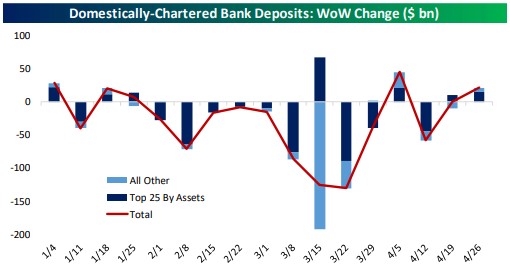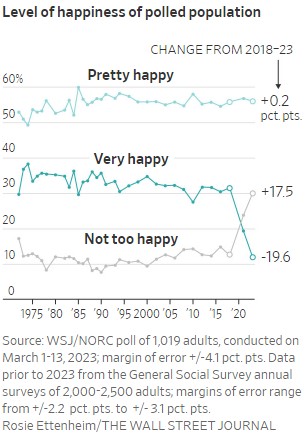Another Tuesday and another big meeting about the debt ceiling… President Biden and House Speaker McCarthy are set to meet again today regarding raising the government’s borrowing limit. Both sides seem like those Zax on the Prairie of Prax, foot to foot, face to face, if you’ll pardon my Seussian reference. Life goes on, as they say, and the longer never-budging continues the more dangerous it becomes.
As we’re all painfully aware at this point, not raising the nation’s borrowing limit would likely lead to a host of disruptive issues for the domestic and global economy and would, of course, also make us look ridiculous on the world stage. The bulk of global trade relies on the dollar and the safety and security it implies. That’s not something to mess with.
We discussed this last week, and I don’t want to bludgeon you with negativity or be overly Pollyannish. With all the rhetoric out there, including from government officials, let’s remember that a technical default by the US Treasury is incredibly unlikely. The politicians on both sides are singing to their bases about what is essentially a political issue, and I have to believe that none of them actually wants to bring the financial system to its knees – the fallout would be extreme and many of these politicians are too pragmatic for that, regardless of what they may say to the press.
But don’t just hear it from me. It’s good to have another perspective, this time from the folks at JPMorgan Asset Management.
The gist here is that the best place to hide, or to ride out expected volatility, is in Treasury bonds. Gold and some other commodities can help but are subject to wide price swings and timing them well is extremely difficult. That bonds equal safety might sound strange since those bonds are issued by the government potentially causing all the volatility. But if history is any guide those bonds performed well during the big debt ceiling standoff in 2011 and the financial crisis of ’08 and ’09, for that matter. Performance in 2011 was ironic because the talking heads on TV were suggesting that investors the world over would dump their Treasurys and buy something else, anything other than debt issued by the US. But investors did the opposite. So will that history repeat itself this time around? I hope the current debt limit debate never gets that far but, if it does, time and again investors have shown a willingness to buy government bonds when things get tough in the markets. I’m not suggesting that you put all your money into Treasurys, by the way, just that what you may already hold should act as ballast during potentially rough seas ahead.
Let me know if you’d like to review your portfolio as it pertains to all this or just talk it through.
Here’s the note I mentioned from JPMorgan...
From the Federal Reserve (Fed) to banking sector weakness, investors already have a long list of risks to consider, to which they can now add heightened concerns around the U.S. debt ceiling. The U.S. reached its debt limit of USD 31.4 trillion on January 19th and has since been relying on funds in the Treasury General Account (TGA) and so-called “extraordinary measures” to fund its obligations. Initial estimates from the Congressional Budget Office (CBO) projected these measures would last until between July and September, but the CBO and Treasury Secretary Janet Yellen now expect the U.S. could run out of funding by early June due to smaller-than-expected April tax receipts.
Still, it is not our base case that the U.S. will default. Lawmakers have raised or suspended the debt ceiling over one hundred times since WWII and under every president since 1959. It is possible that political parties agree to a short-term extension or suspension of the debt ceiling and continue to negotiate over future spending. While budget negotiations may happen given high levels of debt and deficits and rising interest costs, the stakes should not be default.
Some are pondering alternatives to a debt ceiling deal. One option is invoking the 14th Amendment, which states that the validity of U.S. debt shall not be questioned, but that is subject to legal interpretation and could get tied up in the courts. Another option is that debt payments could be prioritized, although it is unclear that operationally the systems and procedures in place are equipped for this. Finally, the Treasury could issue and deposit a trillion-dollar coin at the Fed in exchange for funds in the TGA. This proposal has been largely dismissed by central bankers. Therefore, the path of least resistance is suspending or raising the debt ceiling.
Although default is unprecedented, the best point of comparison for markets is the 2011 debt ceiling standoff and subsequent credit rating downgrade. As highlighted in the chart below, equities faced considerable volatility but, interestingly, Treasury yields fell [meaning bonds prices rose]. Some may have anticipated a rise in Treasury yields as U.S. credit quality was in question, but yields dropped 120 basis points (bps) from one month before the debt ceiling agreement to one month following the debt downgrade. Part of this could have been anticipation of a recession as a result of the turmoil; it could also be attributed to safe haven flows. It should be noted that the flight to safety was likely amplified by the coinciding sovereign debt crisis in Europe. Importantly, there are no cross defaults of Treasuries, so even if there were a default, only the Treasuries that mature when the government runs out of money would default. This is why many money market funds have avoided T-bills that mature around the X-date to manage risk.
Traditional safe havens like gold and the U.S. dollar also protected during the 2011 episode. Gold surged 10.8% in the month leading up to the agreement, topping out three weeks later, up another 15%. The dollar lurched 1.4% in the week leading up to the debt ceiling agreement but mostly reversed in the two weeks following the subsequent credit downgrade.
While some investors may choose to hedge debt ceiling risks through the U.S. dollar and gold, high quality core bonds may protect if volatility picks up. If volatility fails to materialize, core fixed income should still be well supported by slowing economic growth and inflation, which are likely to weigh on bond yields in the coming months.
Have questions? Ask us. We can help.
- Created on .





